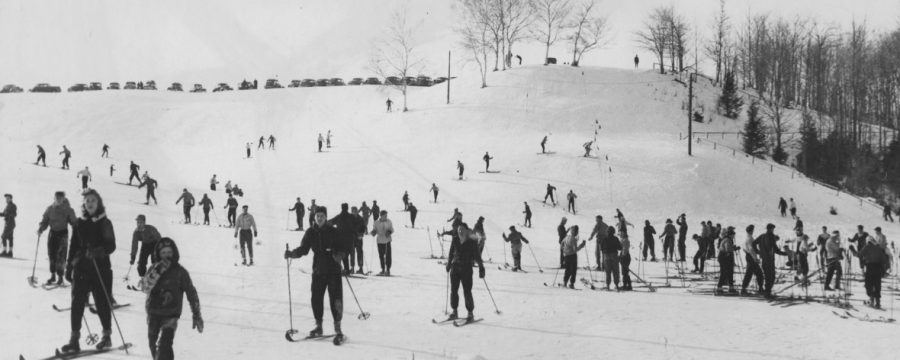A Brief, Incomplete, Semi-Accurate History of Skiing
Early history
What is now an amazingly popular sport started as a simple way to hunt over frozen ground and bogs by the indigenous Sami people of Norway. There is not much information on this period of skiing’s history because it took place in prehistoric times, however we do know that skiing spread quickly through other parts of Scandinavia and even to Russia, this gave rise to novel skis such as wide seven foot tall skis, by the Swiss, that used a long handled club as a rudder to steer when going downhill, as an added bonus the clubs could also be used as snow shovels. By the 3000s BCE skiing had become prevalent in Russia and Scandinavia. A ski from 6300 BCE was found in a Russian bog with other wood workings, this is the earliest known ski. Paintings on rocks depicting skis and skiing further illustrate that skiing was prevalent in certain areas by the 3000s bc the earliest of these paintings being 2500 years old.
The next group to seriously take up skiing were more renowned for their seamanship than skiing ability, but the Vikings brought skiing to the next level. The Vikings used skiing as more than a means of hunting, they worshipped Ellur and Skad the god and goddess of skiing, and according to some accounts may have even skied recreationally. One of skiing’s most interesting and exciting stories also comes from the Vikings. In 1206 a civil war was raging in Norway. To protect his infant son the king asked two of his skier warriors, Thorstein Skevla and Skjerrald Sruka, to bring him safely to Lillehammer, this was done and the baby arrived safely, this inspiring act of courage is commemorated each year with the Breikenbeir cross-country ski race along the route of the original journey. The baby Thorstein Skevla and Skjerrald Sruka, saved became the king of Norway and launched its golden age.
The beginning of modernization
Skipping forward 400 years we see skiing used for two very different reasons the first being warfare and the second being recreation. The Great Northern War, a territorial dispute between Sweden, Russia, and Norway, was fought for a large part on skis. A less violent use for skis developed in the Telmark region of Norway. What originated in Telmark is now known to us as alpine skiing, or going downhill on skis and hopefully turning, But as the people of Telmark soon learned that in order to ski downhill you need to slow yourself down, lest you run into an inconveniently placed rock or tree, thus the Telmark turn, a way to turn where a skier does a sort of lunge and the heel is lifted out of the binding, and Christie turn, where a skier turns by angling both skis diagonally downhill.
The 19th century brought a slew of innovations to skiing. One example being the cambered ski from Norway. The cambered ski has a thin bow like shape, but most importantly bends up in the middle which eliminates the habit of not cambered skis to to bend in the middle under a skiers weight making the skier expend energy getting out of the divot at all times.
Much of skiing’s history so far has ignored North America but the tide starts to turn towards American innovation in the next period of skiing history starting with when when miners from Beloit, Wisconsin became the first to people to be documented recreationally skiing in 1941 when they used their massive ten foot long skis used for going to and from the mines to entertain themselves during the winter. Around the same time that the Beloit miners were enjoying themselves on the hills of Wisconsin alpine skiing was being organized as a sport. About forty years later a new type of ski appeared, made possible by advancements in tools which made hard materials easier to work, the result a ski made from hickory which was much stronger than any other wood used for skis before. The stronger material gave the skis more flex and made them more durable. These skis where for the most part initially made in Norway but that would soon change. In order to make these hickory skis ski makers in Norway needed to import massive amounts hickory from Louisiana, such large amounts of wood leaving the country did not escape the eye of Norwegian immigrants in the midwest, they soon started making their own skis without bearing the expensive cost of importing their wood and soon surpassed Norway setting the U.S up to dominate the ski making trade.
The next development in skis and skiing was the laminated ski made from a base of spruce or basewood with a layer of hickory on each side this gave the skis more flex while maintaining its strength, however the glue holding the layers would unstick quickly making trips to get skis re-laminated frequent.
Shortly after the turn of the century the United States Skiing Association, the governing body for the sport of skiing, was founded marking an important step towards skiing becoming a formalized and competitive sport. What came next to skiing was built with the mere intention to save lives but would revolutionize the sport in ways it’s inventor could not have imagined.
Steel edges were invented by Austrian accountant Rudolph Lettner of Salzburg. Lettner was an avid skier and often skied at a nearby Mountain, one day he lost control and nearly slid into a large rock obstructing the trail. Lettner was only saved by dragging his poles behind him. This incident inspired Lettner to make something to give skiers more control. After nearly ten years of trial and failure he came up with a thin strip of steel on the edge of each ski, which he patented in 1924. For two years the edges did not catch on until the swiss used the to take home the gold from the university of Davos’ winter games, soon all skis had steel edges.
The Chairlift
Arguably the most important factor of skiing’s rise was the invention of the chairlift opening the sport up to those not man enough to hike hours to the top of a mountains. While mechanized means up getting skiers up ski hills had existed as early as 1906, when German farmer and innkeeper Rober Whilerhalder hooked handles onto a continuously moving water powered cable, The credit to the immediate predecessor to the modern chairlift truly belongs to Swiss mountaineer Ernst Constam invented a machine that continuously spun a cable overhead with handles attached at a local mountain in Davos, Switzerland . The modern chair lift was invented after the Union Pacific Railroad Company, of transcontinental railroad fame. Decided to build a ski resort modeled after those in Europe on Idaho’s mountains, the project became what is now Sun Valley, was headed by the chairman of the railroad W. Arvell Harriman.
Harriman in addition to founding sun valley served as a special envoy to Winston Churchill during some of the darkest days of world war two, and was instrumental to the lend lease plan later in the war. Churchill became close friends with Harriman and Harriman even went on to have an affair with Churchill’s daughter in law. Later Harriman was appointed as special envoy to Russia a post which he left in 1946, then in 1948 Harriman served supervising the administration of the Marshall plan. At home Harriman was governor and senator for New York, ran twice for the Democratic party’s presidential nomination, was special assistant to President Truman, served as Presidents Kennedy’s Assistant Secretary of State for Far Eastern Affairs where he implemented the nuclear test ban treaty, advocated for a neutral government in Laos, and helped bring upon the end of the Vietnam war by heading the Paris peace talks. Harriman retired in 1969 but remained an influential figure in world events until his death in 1986.
Harriman sent out a call to Union Pacific railroad engineers to design a method to get skiers up the mountain. The directive reached young engineer Jim Curran, a man who had never and would never ski, Curran remembered a conveyor belt he had seen load bananas onto ships in Panama, with this in mind he designed a system where seats, high overhead, where hung to a turning cable which attached at both the top and bottom of the mountain. When Curran submitted his design to his boss his boss laughed in Curran’s face, however Curran snuck his plan into a pile of other designs for the ski area’s developers, who picked his design. Curran got to work building the beginnings of the world’s first chairlift, using the companies iron foundry, and testing each iteration of the design by strapping two wooden skis onto his feet and attaching the lift to an old car and gliding across a bed of hay on the ground, akin to the nineteen eighties movie Wind starring Mathew Modine Jennifer Gray and Cliff Robertson.
The first chair lift was installed in 1936 on the Proctor mountain of sun valley and was 2360 feet long and reached 643 feet in elevation. The second chairlift was installed on sun valley’s Dollar mountain and was 3540 feet long and reached 1150 feet in elevation. These early lifts had one seat and a blanket to keep skiers warm, employees who folded returned the blankets got skiing privileges.
Sun valley went on to be America’s first destination ski resort, and boasted fine dining establishments, and a pool and ice skating rink. Harriman would invite Hollywood Celebrities to come free of charge to boost the mountains reputation. Whether or not because of Harriman’s ploy sun valley became an enormously popular ski mountain taking in massive amounts revenue .
Skiing’s recent history
Shortly after the debut of sun valley, R.E.D Clark of Cambridge England invented the glue areo lite to hold airplanes together, ski manufacturers soon used it to hold skis together creating more durable lamination. In 1944 dynamic skis would use a cellulose plastic core for their skis. After failing 40 times, in 1949 Howard head, tennis player, areo space engineer and member of the world invention hall of fame came up with a way to make the first commercially successful aluminum ski, using a plywood core between two pieces of aluminum. Head was a major proponent of new materials for sports equipment and founded the company HEAD, which also produced tennis rackets reinforced with aluminum.
Without man made snow the ski season in most of the U.S would be limited or nonexistent, however In 1934 director Alfred E. Green used man made snow for his film As the Earth Turns soon man made snow was popping up all over the country and in the early 1950’s Connecticut’s own Mohawk mountain blew the first man made snow for skiing in the world. Farther from home Bob Lange and Dave Lusser vacuum molded the first plastic ski boot in 1962.. As long as there has been skiing there has been ways to attach your foot to your ski, but for most of history skiers would simply use two straps to hold their regular shoe in, this created problems aside from lack of performance shoes would often slide back and out of the ski, the Sami people solved by making a shoe with a long curved toe part, often seen on pictures of elves today. In 1905 Ernest Reinhard Reizel made the first strapless binding in which a piece of steel was screwed into the toe of the shoe and the shoe pulled into toe irons by a lever. Although it is impossible to pin down the first ski “boot”, what counts as a boot, some post war boots were more akin to a modern snowboarding boot than a ski boot ,this changed when in 1954 a Swiss biker and stunt pilot Hans martin invented the first ski boot with buckles, this made the boot stiffer and more adjustable. In 1963 Lange and Lusser found a way to make their boot from liquid urethane and in 1966 they gave their boot to the Canadian team their boots for the alpine world championships, the Canadians won and by the 1968 winter Olympics fifteen out of eighteen gold medals were won in plastic boots. The secret to plastic skis success is that they are much stiffer than leather making carving, particularly on ice, easier.
In 1967 the first world cup of skiing was raced, organized by Bow Beattie Honore Bonnet and Serge Laus the world cup of skiing was an innovative approach to racing that was designed for television and radio, had a point system based on sailing, and was focused on individuals less than countries. The race is one of skiing’s biggest competition today and is still raced every year with winners receiving a coveted crystal globe.
No piece on skiing would be complete without first acknowledging Warren Miller who through his ski films created much of skiing’s culture today. Warren Miller was born in Los Angeles to an alcoholic father and had what could hardly be considered a stable childhood, because of this he often lived with his grandparents who gave him his first camera. In his twenties Warren Miller and a friend started living in the sun valley parking lot where he had the inspiration to make his first movie. Miller asked six different ski resorts to let him film his movie one, squaw valley, agreed. Miller filmed the resulting film, titled Deep and Light, in 1950 using a borrowed camera. Miller went on to make 500 films with his company Warren Miller twenty of which were sailing films. Warren Miller films featured, in addition to snow kayaks, rebellious skiers in exotic locations, this both gave rise to destination ski areas such as vail, and a rebel ski culture fueled further by figures such as Glen Plake.
If one were to walk through the halls of skiing’s history one would encounter colorful characters, inspiring and not inspiring stories but one would also see how a utilitarian means of transport became a hit sport, the answer, I believe, lies in nothing short of human innovation and resilience the thing that drove the Sami people to first strap two pieces of wood to their feet is the very same thing that caused Jim Curran to design the ski lift.








